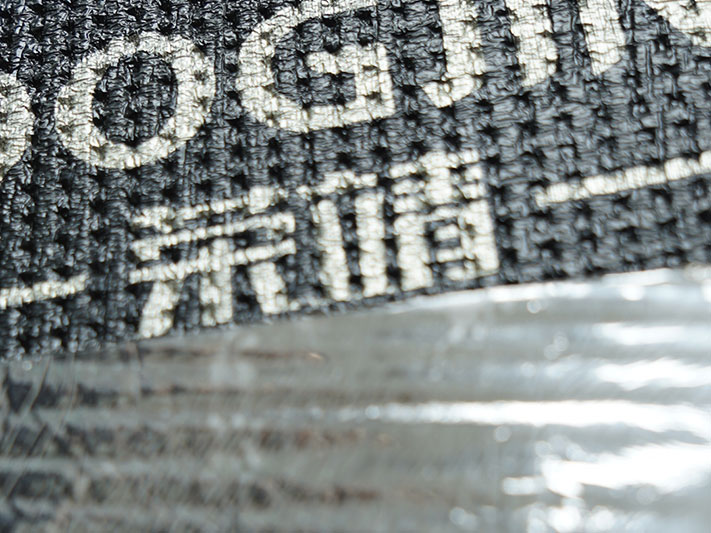
Self-adhesive polymer modified asphalt waterproof membrane, wet paving\pre-laid self-adhesive waterproof membrane
- Package : The coiled material is rolled into a cylindrical shape, suitable for external packaging
- Coil width (m) : 1.0
- Coil thickness (mm) : 1.2 1.5 2.0 3.0 4.0
- Coil length (m) : 10/15/20
- Area (㎡/roll) : 10/15/20
- Upper surface isolation material : polyester film (PET), polyethylene film (PE), aluminum foil, silicon-coated insulation film
- Lower surface isolation material : Silicone-coated isolation film

Self-adhesive polymer modified asphalt waterproof membrane (hereinafter referred to as N type) is based on synthetic rubber such as SBS, high-quality road asphalt and tackifier. Self-adhesive polymer modified asphalt made of polyester film (PET), polyethylene film (PE), aluminum foil or silicon-coated insulation film as the upper surface material, and the lower surface covered with silicon-coated insulation film as the anti-sticking layer Tire base waterproof membrane.
Self-adhesive polymer modified asphalt polyester tire waterproof membrane (hereinafter referred to as PY type) is based on filament polyester felt as the tire base, and the adhesive polymer modified asphalt is used as the dipping coating material. Self-adhesive polymer modified asphalt polyester tire waterproof membrane made of polyethylene film, fine sand, shale, aluminum foil or isolation film as the isolation layer on the upper surface and silicon isolation film as the anti-adhesion layer on the lower surface .
Wide-width self-adhesive pre-laid polyester tire waterproof membrane (hereinafter referred to as pre-laid PY type) is based on asphalt-based polyester tire waterproof membrane as the main material (adding functional additives), coated with a self-adhesive layer on both sides, and attached Self-adhesive waterproof membrane made of peeled silicon-coated film as a separator.
Wide-width self-adhesive polymer pre-coated waterproof membrane (hereinafter referred to as pre-coated P type) is based on ethylene-vinyl acetate (EVA) and high-density polyethylene (HDPE) homogeneous sheets as the main material, and the surface is coated with a "self-adhesive layer" ". It is covered with polymer self-adhesive waterproof membrane made of silicon-coated membrane. According to engineering needs, geotextile can be compounded on the polymer layer to strengthen the strength of the coiled material. Wide-width wet-laid polyester tire waterproof membrane is based on asphalt-based polyester tire waterproof membrane as the main material (adding functional additives), and the self-adhesive layer is coated on one side or both sides. The wet-laid waterproof membrane made of peelable silicon-coated film is used as the insulation material.

1. The special formula and unique manufacturing process make it have the characteristics of cold construction, no open flame, no adhesive, and no pollution to the environment;
2. The polyester felt has high tensile strength and large elongation, and has strong adaptability to the shrinkage, cracking and deformation of the base layer. SBS modified asphalt is used as the coating material, which has good high and low temperature resistance and meets the needs of the exposed waterproof layer;
3. The bonding performance is good, and the joint of the coiled material itself is synchronized with the life of the coiled material;
4. The self-adhesive rubber asphalt on the lower surface of the coil is regularly coated with strips to make it adhere to the base strip and has a unique function:
5. Form a steam exhaust channel to balance the steam pressure of the base layer and avoid the bulging of the waterproof layer;
6. When the base layer shrinks, cracks, and deforms, it can avoid the cracks caused by the "zero extension" of the waterproof layer caused by the full adhesion of the waterproof layer and the base layer.

1. Grassroots requirements:
(1) The waterproof base must be flat and firm, and must not have protruding sharp corners, pits and sanding on the surface. The surface should be clean and dry, and the corners should be rounded with a radius of 50mm according to the requirements.
(2) The water content of the grassroots layer should be free of bright water drops.
(3) Before construction of the waterproof layer, dust, sand, gravel, debris, oil stains and mortar protrusions on the base layer must be removed.
2. Construction preparation:
(1) Construction tools for cleaning the waterproof base: shovel, broom, dust blower (or vacuum cleaner), hand hammer, steel chisel, rag, etc.
(2) Construction tools for roll paving: scissors, tape measure, elastic wire box, roller brush, rubber pressure roller, etc.
(3) The temperature during construction should be above 5℃, and it is not suitable for construction in a particularly humid and unventilated environment. The construction site should have good ventilation conditions.
3. Process flow:
Surface cleaning and repairing of the base layer → Brush the supporting base treatment agent → paste the node parts → position, spring the reference line → lay the self-adhesive rubber waterproof membrane → roll, exhaust → end treatment and overlap → organization acceptance → protection Layer construction.
4. Operation points:
(1) The overall laying order of the coiled material is: high-span first, then low-span; same height, first far and then near; the same elevation, starting from high to low.
(2) Priming: After the base surface is cleaned and accepted, the special base layer treatment agent is evenly painted on the surface of the base layer.The brushing is carried out in one direction, the thickness is uniform, the bottom is not leaked, and the pile is not left. Not sticky.
(3) Stretching and trial laying: The paste control line is popped up on the base coat according to the actual lap area. The trial laying and the actual sticking of the roll material are strictly carried out according to the paste control line to ensure that the width of the roll overlap is 6~7cm (roll There are signs on the wood). According to the characteristics of the site, determine the elastic thread density, so as to ensure that the web material is pasted straight, and the pasting phenomenon will not occur due to the accumulated error. The roll material should be laid in trial first, and the shape should be cut according to the requirements before the actual gluing can be started.
5. Node processing:
①The closing treatment of the parapet wall part: when making cement mortar, the corner of the junction between the wall and the roof should be smeared into a small round corner with a radius of about 50mm. After the base surface meets the requirements, first apply a layer of polyurethane waterproof layer, and immediately after the application is even Attach a carcass reinforcement layer (glass fiber cloth), and then paint the second polyurethane waterproof layer, which is firmly bonded to the base surface, which is also convenient for the construction of self-adhesive coiled material.
② Treatment of yin and yang corners and nozzle parts: the yin and yang corners must be made into 50mm rounded corners with mortar, and an additional waterproof layer is added, and a glass fiber cloth is provided in the additional layer. At the junction of the nozzle and the base surface, after the leveling layer is wiped, the groove is reserved, and the sealing material is embedded, and then the rust and polish are all around the pipe.The waterproof additional layer is provided within 500mm around the nozzle part, and the glass fiber is added Cloth together to ensure a full waterproof effect.
6. Large area paving rolls:
Large-area self-adhesive coiled materials are mainly divided into two types: the pavement method and the roll-laying method. In actual construction, the construction personnel can determine the method of pasting according to the site environment, temperature, sunshine and other conditions, but the basic exhaust and compaction 3. The anti-wrinkle requirements are still the same.
①Basic requirements: When sticking the roll material, you should always align with the baseline to avoid deviations that are difficult to correct. When laying the coiled material, the coiled material must not be forcibly stretched. After pasting, immediately use a pressure roller to roll from the middle of the coil to both sides to expel the air, so that the coil is firmly adhered to the base layer.Do not remove the separator paper at the overlapping part on the back of the coil prematurely, so as not to pollute the adhesive layer or Sticky by mistake.
②Pulling method: lay the roll material in full width with the reference line, lift the roll material (along with separator paper) from one end, fold in half along the length and center of the roll material web, and gently cut the edge of the separator paper with a paper knife. Be careful not to scratch the roll material. Carefully tear the separator paper from the back of the roll material for a short length of about 500mm. The two men work together to peel off the separator paper and align it with the reference line for positioning. First roll the half-length roll in place, pull the peeled release paper evenly and pull it back slowly, and slowly pull out the remaining half-length release paper. Pay attention to the integrity of the drawn release paper when spreading If you find any tears or breaks, you should stop the spreading immediately, and clean up the torn separator paper, and then continue spreading.
③Roll-paving method: that is, peeling the release paper and spreading the roll material at the same time. There is no need to open the entire coil during construction, insert a steel tube into the paper core tube in the center of the coil, and then lift the end of the steel tube by each person to the beginning of the position to be laid, and display the coil forward About 500mm, another person peeled off this part of the roll of insulation paper and rolled it onto the used packaging paper core. Align the strip of peeled release paper with the baseline that has been sprung gently, and then compact it. After the initial end paving is completed, one person slowly lifts and peels the anti-paper and rolls onto the above paper core tube, and moves forward, and the two persons carrying the roll material roll the roll material forward along the reference line at the same time. Note that the moving speed of the two people who carry the coil must be the same and coordinated. Do not relax too much when rolling; after rolling a roll, use a long handle to roll the brush, starting from the beginning, completely remove the air under the roll, and then use a large pressure roller or a hand-held portable vibrator to press the roll In fact, the paste is firm.
④ Paving on the facade and large slope: Since the adhesion between the self-adhesive coil and the base is relatively low, the coil is prone to slip down on the facade or large slope, so it is on the facade or large slope When sticking on the surface, it is advisable to use a hand-held gasoline torch to properly heat the adhesive on the bottom of the coil before sticking, venting or rolling.
⑤ After exhausting and compacting the large-area coil, use a hand-held small pressure roller to roll the overlapped part, roll outward from the inner edge of the overlap, discharge the air, and stick it firmly.
⑥Seam bonding and sealing:
Lap seam paste: The self-adhesive coiled material has a lap edge at the factory. Only the isolation paper needs to be peeled off during bonding. The lap width is generally 6~7cm.
Coil lap sealing: The short side lap joint of the coil, the coil end, the pipe wrap, and the special-shaped part should be sealed with a special sealing paste for self-adhesive rubber asphalt waterproof coil. The sealing width of the overlapping edge is not less than 10cm.
Contact
Add:Taitou Town Industrial Park, Shouguang City, Shandong Province
Mail:rongjing@rongjingwaterproof.com
Facebook:+86-18653628345
Whatsapp:+86-18653628345
Wechat:+86-18653628345

Scan code
Copyright by@2020 Weifang Rongjing Waterproof Engineering Co., Ltd. 鲁ICP备14020741号-1 Power by:www.300.cn
 >
> 


